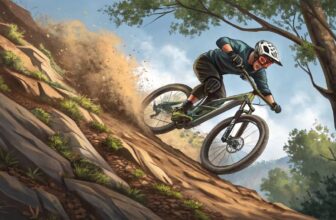Understanding Tubeless MTB Setup
Benefits of Tubeless Tires
When you think of cruising trails with fewer hiccups, tubeless mountain bike setups are a game changer:
- Fewer Flats, More Fun: Ever had a day ruined by a flat tire? Not here! Tubeless systems come with sealant magic that patches punctures while you ride. Say goodbye to those thorn-induced moans and the horrible sound of air escaping from traditional tubes.
- Grip Like a Gecko: Adjust that pressure to get your tire hugging every bump and groove on the trail. Next thing you know, you’re handling corners and climbs like a pro, with better traction holding you steady.
- Shed Some Weight, Not Performance: Removing tubes means a lighter setup, giving you an extra pep in your pedal and better handling out there on the tracks.
- No More Pinch-Fneeds Over Flats: It’s pretty sweet – without tubes, pinch flats are a thing of the past. Tubeless tires grab hold of the rim, saving your day from those nasty rock impacts. A little sealant plugs tiny holes, reducing the flat fiasco (REI).
- Smooth Ride Vibes: Lower tire pressures mean your tires eat up the trail’s lumps and bumps, providing a ride that’s smooth and comfortable (ENDURO Mountainbike Magazine).
Components Needed for Setup
Getting a tubeless MTB setup isn’t rocket science, but you gotta have the right parts in your toolkit:
- Tubeless-Ready Rims and Tires: Lucky for you, most of today’s off-road gear is ready to go tubeless.
- Tubeless Rim Tape: This one’s a big deal. With the tape, you make the rim airtight. It needs to fit your rim’s width perfectly and start at least one spoke hole away from the valve for prime sealing.
- Tubeless Valve Stem: These come in styles and lengths. Get it right by sealing the valve hole using a small tool, lining up the fitting, popping on the O-ring if you’ve got one, and screwing down that valve nut (Park Tool).
- Sealant: Pour it in, and it’s your trusty trail buddy, sealing up any puncture misadventures. Regular checks and top-ups will keep you riding longer (In The Know Cycling).
Grab these essentials to switch up to tubeless style. Need more info on leaping inner tubes?
Dive into these tips, flaunt your new knowledge, and explore our mountain biking essentials to make sure you’re ready for everything out there. Happy trails!
Tubeless Tire Installation Process
Step-by-Step Guide
Getting your mountain bike ready to hit the trails without flats can be a breeze if you follow these simple steps. Here’s how to swap those old tires for a sleek tubeless setup:
1. Prepare the Rim
- Make sure your rim’s ready for tubeless tires. Give it a good scrub to ditch any grime that could mess with a tight fit.
2. Slap on the Rim Tape
- Start the tape at the valve hole and unroll it right down the middle of the rim. Pull tight to keep it smooth and free of bubbles. Let the tape lap over itself when starting or finishing up. It’s like wrapping leftovers in plastic wrap.
3. Pop in the Valve
- Take out the core of that valve. Use something pointy, like a seal pick, to make a neat hole in the tape over the valve hole. Slide the valve through the rim and tape, making sure it’s snug as a bug with the nut holding it in place.
4. Mount the Tire
- Begin by getting one side of the tire onto the rim. Then, ever-so-gently, tuck the other side in, being careful not to mess with the tape or valve that you just expertly installed.
5. Pump It Up
- Blow some air into the tire until you hear or feel those beads sitting nicely. It might take a few tries to lock everything into place right.
6. Squirt in Some Sealant
- With the valve core out, load up an injector with tire sealant (you know the brand you like). Squeeze in the recommended dose, screw the valve core back in, inflate again, then give the tire a good spin and shake. It’s like getting a snow globe ready for winter!
Common Challenges and Solutions
Switching to tubeless isn’t always a walk in the park. Here are some hiccups you might hit and how to handle them like a pro:
| Challenge | Solution |
|---|---|
| Rim Tape Troubles | Choose a tape that sticks strong and is the right width. Start taping away from the valve hole and make sure there’s good overlap for a secure seal. If it still acts up, use a tube first to press the tape firmly down. |
| Leaky Valves | Make sure that the hole for the valve is neat and the valve is straight. Use an O-ring if it comes with one and tighten the nut snugly—no more, no less. |
| Beads Won’t Behave | Inflate all the way to coax the beads into place. If they’re still being stubborn, let out some air and try again. Add a bit more pressure and give the tire a few spins if needed. |
| Pesky Leaks | Get that sealant jiggling around by spinning and shaking the tire often. Keep tabs on it over a few hours, or even days, to see if the leaks shut up shop. |
Looking for more biking know-how? Check out our guide on mountain bike maintenance. Need tips on tire pressure? Visit MTB tire pressure. For those DIY enthusiasts, our diy mountain bike repairs guide is worth a peek.
Ready to hit the trails knowing you won’t be stuck fixing flats every few miles? Happy riding!
Choosing the Right Tubeless Tires
Selecting the perfect tubeless tires for your mountain bike can make all the difference in your trail experience. This guide will help you weigh the important stuff and steer you toward some popular brands. Let’s get rolling!
Factors to Consider
Tire Size
You gotta make sure the tire size matches your bike spec sheet. Most mountain bikes roll on tires that are 26 to 29 inches with different widths. No surprises here, just check your bike before hitting “buy”.
Tread Pattern
Each tread has its comfort zone. If you’re plowing through muddy messes, grab tires with gnarly, aggressive treads. For those hard, dry tracks, smoother treads are where it’s at.
Weight
The lighter, the faster—but keep an eye on durability too. Lighter tires kick up your climbing ease and speed, but might not last as long, so balance it out with how and where you ride.
| Tire Size (inches) | Common Widths (inches) | Approximate Weight (grams) |
|---|---|---|
| 26 | 1.9 – 2.4 | 600 – 900 |
| 27.5 | 2.0 – 2.8 | 700 – 1000 |
| 29 | 2.1 – 2.4 | 700 – 1100 |
Tubeless-Ready or Tubeless
You gotta go tubeless-ready or straight-up tubeless. These bad boys are made to seal without fuss on tubeless rims with the sealant doing its job.
Puncture Resistance
Nobody loves a flat. Opt for high-quality tubeless tires with a bit of a punch in the protection department, like reinforced sides or extra layers—which make a big difference on rough paths.
You might want to check out our guide on mountain bike tire compounds if you’re into tire materials and whatnot.
Popular Tubeless Tire Brands
Maxxis
Known for tough and trusty tires, Maxxis has champions like the Minion DHF and Ardent. They’re loved for grip and keeping those pesky punctures at bay.
| Maxxis Model | Tread Type | Best Suited For |
|---|---|---|
| Minion DHF | Aggressive | Downhill, Enduro |
| Ardent | Versatile | All-Mountain, Trail |
Schwalbe
Schwalbe rolls out super-light tires like the Nobby Nic and Racing Ralph, great for unpredictable rides.
| Schwalbe Model | Tread Type | Best Suited For |
|---|---|---|
| Nobby Nic | Aggressive | All-Mountain, Trail |
| Racing Ralph | Fast-Rolling | XC, Marathon |
Continental
Continental tires, such as Trail King and Mountain King, are beasts when it comes to grip and toughness, making them fan favorites for trail rides.
| Continental Model | Tread Type | Best Suited For |
|---|---|---|
| Trail King | Aggressive | Downhill, Enduro |
| Mountain King | Versatile | All-Mountain, Trail |
Specialized
Specialized tires like the Butcher and Ground Control bring home the bacon with their traction and stability.
| Specialized Model | Tread Type | Best Suited For |
|---|---|---|
| Butcher | Aggressive | All-Mountain, Trail |
| Ground Control | Versatile | XC, Trail |
Take a peek at our mountain bike maintenance guide for any upkeep tips.
When you land on the right tubeless tire, it’ll set your MTB suspension setup dialed for a smoother, puncture-free adventure. So, give it a whirl and pick what fits your ride best!
Keeping Your Tubeless MTB Tires In Tip-Top Shape
Keeping your tubeless mountain bike (MTB) tires in good condition is super important. It helps you avoid those annoying flat tires that can ruin a good ride. Let’s dive into the nitty-gritty of making sure your tires keep you cruising on the trails.
Give Those Tires a Good Look-See
Take a peek at your tubeless MTB tires now and then to nip any problems in the bud. Notice any worn patches, random holes, or gunk stuck in them?
Things to Check:
- Examine the tire tread—is it looking a bit too smooth?
- Peek at the sidewalls for any cuts or scrapes.
- Make sure the tire is snug against the rim.
- Check for gooey sealant around the tire, hinting at sneaky leaks.
Stay on top of these check-ups to keep your tires in shape, so they don’t give out on you mid-ride.
Topping Up the Goo and the Air
The magic goo called tubeless sealant can dry out and become useless at stopping punctures. Give it a top-up every half year. Checking the goo is as easy as giving your tire a good shake—do you hear it swishing about?
How to Refill Sealant:
- Do the Shake Test: Listen for the sealant sloshing around.
- Pop the Valve Core: Use a special tool to remove it.
- Add More Sealant: Stick the new sealant in with a syringe or special injector.
- Seal It Back Up: Quickly put the valve core back in before you lose too much air.
| How Often | What To Do |
|---|---|
| Every 6 months | Add more tubeless sealant |
| Every ride | Check air pressure |
Pump It Up Just Right:
Keep an eye on the air pressure for the best ride quality. Head over to our MTB tire pressure guide to find the sweet spot for your biking style and terrain.
- Double-Check Pressure: A digital gauge is your best friend for accuracy.
- Adjust as Needed: Pump it up or let some air out until it’s just right.
Keeping the pressure and sealant where they should be will help your tires tackle any challenge. For more handy tips on keeping your mountain bike spry and ready, visit our mountain bike maintenance page.
Transitioning to Tubeless Setup
Switching from an inner tube system to a tubeless setup can seriously up your game on the trails. You get a grip, you can ride with lower tire pressures, and you won’t be patching up flats every other mile. Who wouldn’t want that? Here’s how to make the switch happen.
Inner Tube to Tubeless Conversion
Ready to ditch those tubes? Here’s what you’ve gotta do:
- Get Rid of the Inner Tube: First thing first—let the air out of your tube and pull it out.
- Clean it Up: Make sure the rim is cleaner than a whistle.
- Install Tubeless Valve: Pop that tubeless valve into the rim and make sure it’s snug.
- Mount the Tire: Fit your tubeless-ready tire onto the rim and pump it up a bit to seat the bead.
- Pour in Sealant: Add some sealant in there. Usually, you’ll need between 2 to 4 ounces depending on your tire size.
- Pump it Up: Inflate to the recommended pressure. You might need a special pump for this part.
- Spin and Check for Leaks: Give the tire a good spin to spread the sealant around and seal up any tiny holes. Don’t skip this part!
Curious about some DIY bike fixes? Dive into our daily mountain bike repairs article.
Tools and Supplies Needed
Here’s your gear list for making the tubeless magic happen:
| Tool/Supply | Purpose |
|---|---|
| Tubeless-Ready Tire | Ensures the tire seals properly with the rim. |
| Tubeless Rim | Lets you secure that seal. |
| Tubeless Valve Stem | Essential for sealing and keeping pressure. |
| Tire Sealant | Fills in those pesky punctures and keeps air from escaping. |
| Tubeless Rim Tape | Keeps air in by sealing the spoke holes. |
| Tire Lever | Makes it easier to swap the tires. |
| Tubeless Inflator Pump | Aids in locking the tire bead into place with proper air pressure. |
Nailing the conversion requires the right tools. Got a question about pressure? Our guide on mtb tire pressure has all the deets.
Sure, setting up a tubeless system takes a bit of work and some gear, but the payoffs in how smoothly and confidently you ride will make it all worth it. Just starting out on your biking journey? Check out our mountain biking basic skills guide to kick things off.
Troubleshooting Tubeless MTB Setup
Getting into a tubeless mountain bike setup is like owning a rebellious pet—sometimes they’re unpredictable, but totally worth it if you handle them right. You’re out on the trail and bam—leaks and tire punctures pop up uninvited. Have no fear, there’s a fix for that, and it’s as essential as a cold drink on a hot day.
Dealing with Leaks
Leaks are like unwanted guests—they show up when you least expect them. But, with a bit of know-how, you can kick them out fast.
- Rim Tape and Valve Seal: The rim tape’s gotta be flawless. Start the tape on the opposite side of where the valve stem should go, overlap it right, and make sure it’s stuck on tight. Oh, and don’t forget to tighten that valve like it owes you money.
- Resetting the Bead: Tire beads are like cats—they’ll wander off occasionally. Inflate the tire to its max and watch it snap right back into place before letting out some air to your likin’.
- Sealant Top-Up: Keeping your tire sealant fresh is like keeping your plants watered—skip it, and they both die. Now and then, pour in about 2oz for a day trip or 8oz if you’re adventuring far.
Handling Tire Punctures
Even tough tubeless tires can have a bad day. When they do, it’s time to act.
- Tire Plugs: These little wonders fix big messes. Stick brands like Dynaplug Micro Pro in your tool kit. They eat small cuts for breakfast.
- Sealant: Keep your repair kit overflowing with sealant—think 2oz to keep the little leaks away and 8oz for the big guns.
- Spare Tubes: Sometimes a patch just won’t work. You’ve gotta be ready to drop the tubeless act and throw in a spare tube. Make sure you know how to do the tubeless tango and switch that setup.
- Sidewall Repairs: The tire gets a nasty cut? Bust out your sewing kit, complete with a curved needle and some retired tire sidewall, because we’re playing tough love here. A bit of super glue or a trusty patch kit can work wonders too.
Essential Tools and Supplies
To handle surprises on your ride, a solid toolkit is like your safety net—don’t hit the trails without it!
| Item | Use |
|---|---|
| Tire Sealant | It’s your insurance policy against small disasters |
| Spare Tubes | For when the road gets too bumpy to fix |
| Gorilla Tape | Instant rim tape doctor |
| Patch Kit | Little nightmare, meet your match |
| Super Glue | For sidewall stitching |
| Spare Valve | Keep the tire chatty—replace the broken |
| Tubeless Plugs | Zaps those large punctures |
| Curved Needle | Tailor your tire’s tears |
| High Volume Pump | A must-have to sort that tire bead mess |
With all this gear in your corner, flat tires and leaks will be just a minor speed bump. Check out our mountain bike maintenance guide for more nuggets of wisdom.
If you need more details on going tubeless, including the stuff you need, mosey on over to our guide on transitioning to a tubeless setup. Wanna ride carefree? This stuff has got you.
Boosting Your Tubeless Setup Game
If you wanna squeeze every bit of awesomeness from your tubeless MTB setup, there are tweaks you should try. We’re talking about tubeless inserts and perfect tire pressures.
Rockin’ Tubeless Inserts
Tubeless inserts are like your bike’s secret weapon. They save your rims from nasty surprises like pinch flats and keep your tires steady, making them perfect for those rough-and-tumble trails. Plus, they let you drop the pressure in your tires so you can grip the ground like a pro on those tricky paths.
But hey, don’t get too hyped just yet. Tubeless inserts add some heft, make screwing and unscrewing tires more of a chore, burn through more sealant, and might make your wallet cry. While these perks sound sweet, not every biker needs ’em.
Why You’ll Love Tubeless Inserts:
- Pinch Flat Protection: Keeps the rim safe from those hard knocks.
- Sidewall Stability: This keeps you in control of the wild rides.
- Lower Tire Pressure: This means more grip on the trail.
| Benefit | Impact |
|---|---|
| Pinch Flat Protection | Protects rim and tire |
| Sidewall Stability | Gives better control |
| Lower Tire Pressure | Boosts traction and grip |
Curious about keeping your tires safe and sound? Visit our handy mountain biking safety tips article.
Nail That Tire Pressure
The magic spot for tire pressure is key to making your ride smooth and comfy. Go too high, and you’ll lose grip and feel every bump. Too low, and you risk crunching your rims and flats.
Stuff to Think About for Tire Pressure:
- Rider Weight: Heavier folks should pump up a bit more.
- Trail Type: Bumpy routes ask for slightly lower pressures for extra hold.
- Tire Size: Bigger tires laugh in the face of high pressure because of their roomy insides.
| Rider Weight (lbs) | Front Tire Pressure (psi) | Rear Tire Pressure (psi) |
|---|---|---|
| < 150 | 18-22 | 20-24 |
| 150-180 | 22-26 | 24-28 |
| > 180 | 26-30 | 28-32 |
Hitting the sweet spot with your tire pressure can be a game-changer for your ride’s vibe. Want more deets? Check out our MTB tire pressure guide.
By popping in tubeless inserts and fine-tuning tire pressures, you can take your tubeless adventures to the next level. For more tips and tricks, make sure to peek at our mountain bike maintenance and MTB suspension setup guides.
Tubeless Setup for Better Riding
Getting the hang of your tubeless mountain bike (MTB) setup involves knowing what parts you’re dealing with. Let’s look at those special tubeless valves and why keeping your bike clean and tidy matters.
Special Tubeless Valves
Those little tubeless valves are key players in making sure your MTB runs smoothly and steadily. They come in all different shapes and sizes—mostly about how long they are. Here’s the lowdown on getting them in place:
- Poke a hole through the tubeless tape using a tool like a seal pick or even a skinny screwdriver.
- Slide that valve through the tape and into the rim’s valve hole.
- Check that it’s sitting right inside the rim.
- If an O-ring’s involved, get it on there.
- Screw the valve nut on snugly so no air sneaks out.
Getting these steps right stops pesky air leaks and keeps your tires pumped and ready for action. Good valve installation lets you enjoy the perks of less air pressure and better grip with tubeless tires.
Keep It Clean and Running Smooth
To keep your tubeless MTB cruising without a hitch, you gotta check on it and clean it up every now and then.
- Look Over Everything: Always peek at the sealant levels and tire pressure. Keep an eye out for any worn spots, holes, or stray bits stuck in the tire.
- Top Up Sealant: The gooey stuff inside your tubeless tires is what keeps flats at bay and plugs holes automatically. Plan to add or swap out sealant every few months, say every 2 to 6, depending on where and how you ride.
- Clean Up Time: Give the rims and tires a good scrub before you put the tubeless gear on. Make sure the tape isn’t peeling or damaged and swap it out if needed. Cleaning up any old sealant leftovers helps keep things airtight and your setup in top shape.
- Get the Right Pressure: Adjust tire pressure for the trails and how you ride. The right amount of air boosts grip and lowers the chances of pinch flats. Check out our mtb tire pressure guide for detailed advice.
Keeping your setup in peak condition can make it last longer and perform better. To learn more about looking after other bike parts like brakes and suspension, see our mountain bike brakes comparison and MTB suspension setup.
By focusing on those special tubeless valves and sticking to a solid routine of maintenance, you’re setting up your tubeless MTB to excel on whatever paths you choose to ride. This means more fun and fewer hassles. For even more pointers on keeping your bike in shape, visit our mountain bike maintenance guide.




